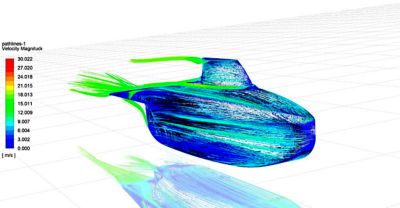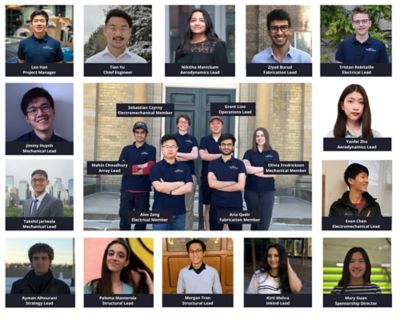-
-
Kostenlose Software für Studierende
Ansys unterstützt die nächste Generation von Ingenieur*innen
Studenten erhalten kostenlosen Zugang zu erstklassiger Simulationssoftware.
-
Verbinden Sie sich jetzt mit Ansys!
Gestalten Sie Ihre Zukunft
Stellen Sie eine Verbindung mit Ansys her, um zu erfahren, wie Simulation Ihren nächsten Durchbruch vorantreiben kann.
Länder und Regionen
Kostenlose Demoversionen
Produkte & Dienstleistungen
Lernportal
Über das Unternehmen
Back
Produkte & Dienstleistungen
Back
Lernportal
Ansys unterstützt die nächste Generation von Ingenieur*innen
Studenten erhalten kostenlosen Zugang zu erstklassiger Simulationssoftware.
Back
Über das Unternehmen
Gestalten Sie Ihre Zukunft
Stellen Sie eine Verbindung mit Ansys her, um zu erfahren, wie Simulation Ihren nächsten Durchbruch vorantreiben kann.
Kostenlose Demoversionen
ANSYS BLOG
August 1, 2022
Catching Some Rays: Students Design Solar Race Car with Simulation and the Sun
As millions of college students prepare to soak up the sun this summer on vacation, engineering enthusiasts at the University of Toronto have other plans for the fiery sphere. The university’s Blue Sky Solar Racing team is designing a solar race car to catch enough rays to finish as a top contender at the World Solar Challenge (WSC) next year. With more than 60 current members, the student team consists mostly of undergraduates with backgrounds in engineering, computer science, business, and marketing. Despite their diverse areas of study, they’re all gaining hands-on simulation experience.
From the front- to the rear-end of the vehicle, the team integrates Ansys simulation solutions to design a winning solar race car with the least amount of aerodynamic drag, the highest solar energy intake, and the lowest energy losses in its electrical system.
With access to Ansys simulation tools through a student team partnership under the Ansys Academic Program, the team iterates calculations, models, and designs more quickly, accurately, and seamlessly across all parts and subsystems of the car. The partnership provides student teams with free research software and support for use with their competition designs.
As a result, their solar car is well-equipped for competition and, with real-world engineering experience, the team is well-equipped for life after graduation with a career forecast of clear skies and sunny days ahead.

Blue Sky Solar Racing completes a static structural analysis in Ansys Mechanical to ensure the safety of their solar race car, Borealis. This simulation illustrates the lower control arm of Borealis’ rear suspension.
Simulating for the Sun
This isn’t the team’s first rodeo — or race. Blue Sky Solar Racing has been around since 1997. Historically, the team participates in the biennial WSC race — a 3,022-kilometer (roughly 1,878- mile} race spanning the Australian continent — faithfully every two years.
The team’s latest race car, named Borealis, marks the team’s 11th-generation race car model and bears a similar lean and lengthy resemblance to its earlier models at 5 meters long (the maximum length allowed by WSC) and around 1.1 meters in width and height.
Leo Han, the team’s project manager, says a long and skinny design reduces aerodynamic challenges, but aerodynamics isn’t the only matter of concern. Race regulations include a host of requirements, including the vehicle’s energy storage, occupant space, driver’s and electrical safety, steering, brakes, and more.
“We currently use Ansys simulation across all subsystems of the car, including mechanical, structural, and aerodynamic,” says Han. “A lot of the proof and justification for our design documentation to the competitions’ regulatory boards actually comes in the form of simulation results. We send over our Ansys simulation results, plots, and data to justify that our design is safe and meets regulations.”
For Borealis’ development, the team has used Ansys Mechanical and Ansys Fluent most for structural and fluid analyses, respectively, while relying on Ansys Speos in the past to optimize headlight reflectors — an optical design that is still being used to boost the car’s beams.
While the size of the team fluctuates from year to year, at least 20 members actively use Ansys finite element analysis (FEA), computational fluid dynamics (CFD), and optical design software during most development periods. The team has several departments, including mechanical, aerodynamics, electrical, array, electromechanical, structures, strategy, fabrication, and advancement.
All groups share a dedicated space on campus across from one of the university’s main engineering buildings. The shop is outfitted with a garage door to easily transport the car in and out, as well as an adjacent computer lab with multiple workstations where team members perform analyses, calculations, and simulations. The team makes good use of the facility yearround in preparation for the race, which involves prerequisites. In addition to sending advance documentation to meet regulation standards, the WSC requires the solar car to pass a preliminary "scrutineering" round one week before the competition in order to race in the main event.
Scrutineering typically consists of mechanical and electrical inspections as well as dynamic tests such as U-turns and figure-eight maneuvers. While the full WSC schedule for 2023 has not been released as of press time, the competition generally runs up to two weeks, including about five days for scrutineering.

Members of the team’s aerodynamics department use Ansys Fluent to analyze velocity and speed. This simulation shows a study done using a NACA airfoil.
Building a Winner, Safely
Aside from energy efficiency, the most important aspect of a solar race car — or any race car — is safety. While safety affects every facet of the car, one of the most critical areas to secure structurally is the space surrounding the driver.
Paloma Manterola, a Structural Lead on the team, uses Ansys FEA simulation to ensure safety around this hot seat.
“I’ve mostly used Ansys Mechanical to optimize all the chassis or the roll cage, which are basically the parts that surround the driver and protect them in case of a crash, rollover, or any kind of disaster,” says Manterola. “Protecting the driver is the main issue and the main goal of the team. Ansys simulation has really helped us in that regard while also helping us to potentially perform well in the race.”
The primary challenge for Manterola and her group has been to optimize the chassis, which is made of sandwich panels consisting of carbon fiber layups, while balancing weight and strength. The goal is to optimize the chassis so it doesn’t weigh down the vehicle, while still safeguarding the driver in any scenario.
To achieve this, Manterola and the rest of her group use Mechanical in combination with Ansys Composite PrepPost (ACP). ACP is an integrated tool in the Ansys Workbench simulation integration platform with preprocessing (ACP-pre) capabilities for composite laminates modeling and post-processing (ACPpost) capabilities for advanced analysis using failure tools.
First, the team uses ACP-pre to construct the sandwich panels and carbon fiber layups. Next, the members shift to ACP-post to get the results of structural analyses, including maximum principal and stress deformation.
Once this data is collected, the group uses Mechanical to identify values for points of maximum deformation or maximum principal stress. After these points are identified, it’s back to design.
The team can now determine which areas of the chassis they can adjust. Some areas may suffice with fewer layers of carbon and a lighter core, while other areas require more layers of carbon and a stronger core for extra strength. A similar process is completed for Borealis’ outer body to reduce the overall weight of the vehicle while still protecting the driver.

The Blue Sky Solar Racing student team at the University of Toronto is designing a solar race car to compete at the World Solar Challenge next year.
Jimmy Huynh, a Mechanical Lead, explains how their team also uses Mechanical to test the vehicle’s suspension system.
“We use Ansys Mechanical to test the loads that we calculate based on the regulations that the WSC sent out, and we use rigid dynamics to get proper mechanical movement and test the entire suspension system to make sure there’s no clashing,” says Huynh. “We make sure that the car moves with the wheel characteristics that we’ve set up, and then also that it doesn’t interfere with any of the other subsystems.”
They also employ Mechanical’s rigid dynamics capabilities to test smaller mechanical systems throughout the car, such as hinges.
Additionally, the aerodynamics group uses Fluent to understand and improve the aerodynamics inside and outside of the car with built-in tools for electric motor cooling, turbulence modeling, and combustion models.

Ansys Mechanical simulation showing maximum stress generated in axle.
Getting an Edge on the Competition
Another component that the team must consider is weather. If you wondered if a solar race car fares best on sunny days, it does. But it’s not just the sun that impacts conditions.
While a cloudy day can reduce Borealis’ energy input by two-thirds, a strong headwind could double power consumption due to aerodynamic losses. On the other hand, a tailwind could help reduce aerodynamic losses. To consider all weather-related variables, the team analyzes forecast data, then inputs the information into Ansys’ simulation software. Using these results, the team runs additional simulations for a wide range of conditions to determine possible solutions, such as at what speeds to operate the vehicle during certain wind conditions to perform best in the race.
Though the bulk of Borealis’ power is dependent on the sun, all teams are allowed to start the race with an initial full battery pack charge, which allows around 3 hours of driving at 70 km/h.
While this could be considered a slight head start, it pales in comparison to the edge that Ansys’ predictive accuracy has given the team, at least according to its members.
“We’re doing simulations on a 5-meter-long car, and just the sheer volume of that, you wouldn’t expect simulation to give you that much accuracy. But every time I refine the mesh, Ansys Mechanical gives me more and more knowledge of how I need to fix something — maybe change a corner angle to make it less sharp,” says Manterola. “Just being able to have that information really helps a lot. And yes, Ansys can work with this massive model while also giving accurate and fast results. It also allows us to easily move back and forth from other tools to Ansys’ simulations, which makes the iteration process so much faster.”
Manterola applauds the Ansys Academic Program for not only providing tools, but also for offering support online. By using the Ansys Learning Forum and Ansys Learning Hub, Manterola and her teammates found solutions for many common issues, including the root cause of error messages. Additionally, Tak Jariwala, another Mechanical Lead on the team, helps new recruits learn the software through the team’s onboarding training program. In his experience, even members new to simulation embrace Ansys’ tools rather quickly.
“Overall, I think the learning curve is generally steep because a lot of our recruits come in as first-year or second-year students, where they haven’t had much experience with our coursework yet,” says Jariwala. “But we try to make our training modules fairly intuitive, and I think Ansys simulation especially is easy to learn once you have exposure to one or two sessions. It’s fairly straightforward and easy to pick up with time.”
With forecasting and simulation well understood, the only thing left for the team to figure out is who will take the wheel. Ideally, the team selects three drivers to alternate driving and alleviate the burden, which includes daily 9-hour driving shifts. for about one week.
9-hour driving shifts. for about one week. However, few team members have their driver’s license yet due to so many test cancellations during the pandemic. Adding to this challenge, the size restrictions of Borealis’ driver hub create another hurdle, favoring the team’s shortest and smallest drivers.
As the group tries to find additional candidates, Han plans to, quite literally, take one for the team and get behind the wheel. In the meantime, Borealis is ready and waiting to be steered to a victory.